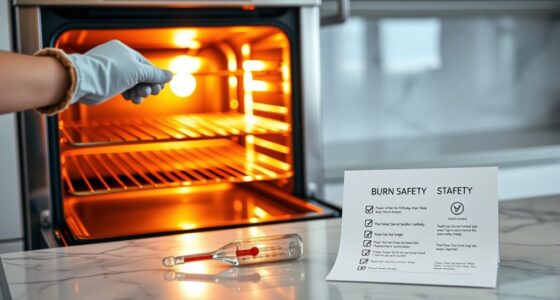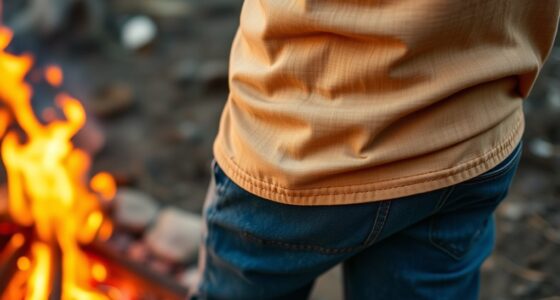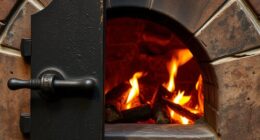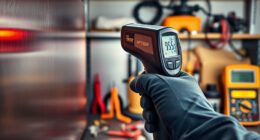If a fire breaks out in your wood-fired oven, act quickly by turning off the airflow to cut off oxygen and slow the flames. Use a suitable fire extinguisher aimed at the base of the fire and sweep side to side until it’s completely out. Never pour water on a wood fire, as it can cause dangerous flare-ups. To learn more essential safety steps, keep exploring the best ways to manage emergencies effectively.
Key Takeaways
- Immediately turn off the oven’s airflow by closing the damper or air vent to cut oxygen supply.
- Use a suitable fire extinguisher aimed at the fire’s base, sweeping side to side until flames are out.
- Carefully remove burning logs or embers with long-handled tools if it is safe to do so.
- Keep a fire extinguisher nearby and familiarize yourself with its operation for quick response.
- Monitor the oven until completely cooled and ensure the fire is fully extinguished before resuming use.

Have you ever wondered what happens when a critical system needs to be stopped immediately? When it comes to a wood-fired oven, quick action can prevent disaster and guarantee everyone’s safety. Knowing how to effectively execute an emergency shutdown is essential, especially when fire safety concerns arise unexpectedly. Immediate response can mean the difference between controlling a small flare-up and dealing with a full-blown fire that threatens your property and safety.
In emergencies, quick action with your wood-fired oven can prevent disaster and ensure safety.
The first step in an emergency shutdown is to stay calm and assess the situation quickly. If you notice flames spreading or smoke intensifying, you need to act fast. Remember, your priority is to prevent the fire from escalating while protecting yourself and others nearby. Keep a fire extinguisher nearby, preferably a Class A or multipurpose extinguisher suitable for wood fires, and familiarize yourself with its operation beforehand. Regular oven maintenance plays a critical role here; a well-maintained oven reduces the risk of unexpected flare-ups triggered by creosote buildup or faulty vents. Proper oven maintenance also ensures that safety features are functioning correctly, allowing you to shut down the system safely when needed.
Once you’ve identified the need for an emergency shutdown, turn off the airflow to the oven. This slows the combustion process, limiting the fire’s fuel source. If your oven has a damper or air vent, close it immediately. Doing so helps suppress the flames by cutting off oxygen, which is essential for combustion. After reducing airflow, carefully remove any burning logs or embers, but only if it’s safe to do so. Use long-handled tools to avoid burns or injury. If flames persist or seem uncontrollable, the next step is to use your fire extinguisher. Aim the extinguisher at the base of the fire and sweep side to side until the flames are extinguished. Never pour water directly onto a wood fire, as this can cause dangerous flare-ups or damage to your oven.
In addition to these immediate actions, it’s essential to follow proper oven maintenance routines to prevent emergencies. Regularly clean ash and creosote buildup, inspect seals and vents, and ensure safety devices are operational. These measures reduce the likelihood of fires starting unexpectedly, making your oven safer to operate. Incorporating regular maintenance into your safety protocol can significantly lower emergency risks. After extinguishing the fire, monitor the oven closely until it cools completely, and check for any damage or signs of malfunction. Remember, even after the flames are out, residual heat can reignite embers, so never leave the site unattended until you’re certain everything has cooled and cooled safely.
Frequently Asked Questions
Can I Use Water to Extinguish a Wood-Fired Oven Fire?
You shouldn’t use water to extinguish a wood-fired oven fire, as it can cause dangerous steam or crack the oven. Instead, follow emergency procedures by using a fire extinguisher rated for wood and grease fires. If the fire is small, carefully use the extinguisher. Always prioritize safety, and if the fire gets out of control, evacuate and call emergency services immediately.
What Safety Gear Should I Wear During Emergency Shutdown?
In a fiery emergency, your safety takes priority. Wear protective gloves and a fire-resistant apron to shield your skin. Don’t forget a face shield to protect your eyes from heat or sparks. Keep a fire extinguisher nearby, ready to act quickly if needed. These safety gears not only safeguard you but also give you confidence to handle the crisis swiftly and safely, preventing injuries and minimizing damage.
How Long Does It Take for the Oven to Cool Down After Shutdown?
After shutting down your wood-fired oven, it typically takes about 1 to 2 hours for the oven temperature to drop considerably, depending on the oven’s size and surrounding conditions. During this cooling duration, you’ll notice the temperature gradually decreases, ensuring it’s safe to handle or open the oven again. Keep an eye on the temperature gauge or use an infrared thermometer to monitor the cooling process accurately.
Is It Safe to Leave the Fire Unattended During Shutdown?
It’s not safe to leave the fire unattended during shutdown because it can compromise fire prevention and oven maintenance. Always guarantee the fire is fully extinguished before leaving the oven unattended. Properly managing the fire prevents accidental flare-ups and reduces risks. Regular oven maintenance includes checking that all embers are out and the fire is completely extinguished, ensuring safe operation and fire prevention for your wood-fired oven.
What Are the Signs of an Oven Malfunction During Emergency Shutdown?
During an emergency shutdown, watch for signs of oven malfunction like unusual oven temperature fluctuations or excessive smoke emission. If the oven’s temperature spikes unexpectedly or smoke becomes thick and persistent, these indicate a problem. Stay alert to abnormal odors or flames. If you notice these signs, immediately stop the shutdown process, ventilate the area, and contact emergency services to prevent fire hazards or damage.
Conclusion
In an emergency, quick action is your best friend. Remember to close the oven door, turn off the air supply, and use a fire extinguisher if needed—think of it as your secret weapon, like a knight’s trusty sword. Stay calm, act swiftly, and keep safety your top priority. With these steps, you’ll handle a wood-fired oven blaze faster than you can say “Great Scott!” and keep everyone safe, just like a true hero of yore.









